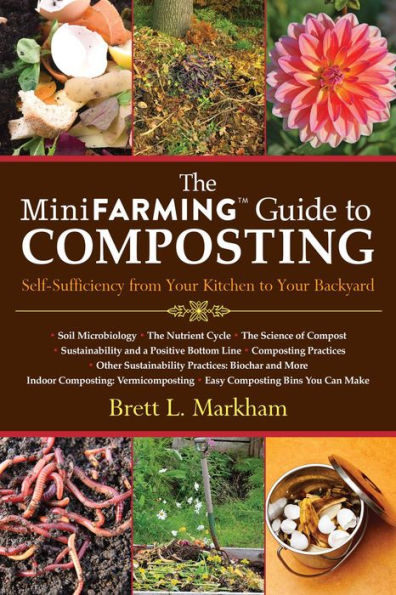
The Mini Farming Guide to Composting: Self-Sufficiency from Your Kitchen to Your Backyard
224
The Mini Farming Guide to Composting: Self-Sufficiency from Your Kitchen to Your Backyard
224Paperback
-
PICK UP IN STORECheck Availability at Nearby Stores
Available within 2 business hours
Related collections and offers
Overview
Maximize your vegetable output! Increase your self-sufficiency! And be kind to the ecosystem!
Brett L Markham is here to help you get started in his new handbook that covers everything you need to know about composting. Whether it's your mini farm or flower garden that need nourishment, Markham explains how to compost just about anything you can grow - and reminds us that developing your own composting practices not only can be fun but also saves money and encourages self-sufficiency. His guide includes:
- Soil Microbiology
- The Nutrient Cycle
- The Science of Compost
- Sustainability and a Positive Bottom Line
- Biochar
- Indoor Composting
- And more!
Learn to make a backyard compost structure with Brett's easy-to-follow directions and learn the science behind how your food scraps become food for plants. In the Mini Farming Guide to Composting you'll find easy instructions that make composting simple.
“Nearly all books that cover compost concentrate only on aerobic composting with a special emphasis on thermophilic composting. But this is not, in my opinion, enough to make someone self-sufficient. For example, maybe you have noticed that you need compost for soil blocks when you are starting your onion seedlings in January, but your outdoor compost pile is going to be frozen until April so it won’t do you any good. Or maybe you have a back or leg injury, and turning a two-ton thermophilic aerobic compost pile is simply not feasible. Because nature is on your side, there are a lot of different ways to create compost, and all that is really necessary is an underlying understanding of the nature of the processes at work and an eye toward safety to adapt numerous methods to your situation. I personally use many methods both indoors and outdoors, and this book will help you do the same.”

Product Details
| ISBN-13: | 9781616088583 |
|---|---|
| Publisher: | Skyhorse |
| Publication date: | 03/06/2013 |
| Pages: | 224 |
| Sales rank: | 884,804 |
| Product dimensions: | 6.00(w) x 8.90(h) x 0.90(d) |
About the Author
Table of Contents
Acknowledgments ix
Chapter 1 Introduction to Composting 1
Why Use Compost? 3
Why Make Your Own Compost? 7
Chapter 2 Starting with the Soil 13
Analyzing Your Soil's Water Characteristics 14
Analyzing Your Soil's Biological Activity 17
Analyzing Macro-nutrients and pH 23
Interpreting Soil Test Results 25
Compounding Your Own Fertilizer 26
Micro-nutrients 32
pH 39
Chapter 3 Biochar 47
Biochar Application Rate 49
How to Apply Biochar 50
Commercial Sources of Biochar 51
Making Your Own Biochar 52
Chapter 4 Compost Science and the Nutrient Cycle 57
Biology and Chemistry of Compost 64
Pathogen Destruction 69
Pathogens and Composted Manure 73
Prions 76
Moisture Content 76
Carbon/Nitrogen Ratio 79
Humic Substances 84
Chapter 5 Anaerobic Composting 89
Anaerobic Microbes 91
Overview of Anaerobic Techniques 93
Open Pile Anaerobic Composting 94
Anaerobic Container Composting 95
Buried Composting 96
Garbage Bag Composting 96
Septic Style Composting 97
Caution 100
Chapter 6 Aerobic Composting 103
Mesophilic Phase 106
Thermophilic Phase 107
Maturing and Curing Phase 107
Ingredients 108
Moisture 110
Aeration and Turning 111
The Process in a Nutshell 115
How to Check Compost Maturity 116
Where to Put Your Piles 117
Compost Bins, the Easy Way: With Chicken Wire 118
Additives 120
Chapter 7 Indoor Mesophilic Composting 123
Indoor Mesophilic Compost Ingredients 126
Carbon Sources 126
Making the Drums 128
Making the Rotation Cradle 130
Making the Bucket Screen 132
Chapter 8 Vermicomposting 135
The Mighty Earthworm 136
Your Worm Bin 139
Bedding 140
How Many Worms Do You Need? 142
What and How to Feed Your Worms 143
Unintended Critters 145
Dividing Your Worm Herd 148
Harvesting Your Vermicompost 149
Chapter 9 Composting Human Waste 153
Why Is Urine Yellow and Why Are Feces Brown? 154
Urine: What Is It? 156
Feces: What Are They? 158
Contextualizing the Hazards of Human Waste 159
Your Emergency Toilet 164
What to Add to Your Waste 165
Composting Human Waste Outside 167
What if You Can't Compost in an Emergency? 170
For More Information 172
Chapter 10 Sheet Composting/Lasagna Gardening 175
How It Works 176
Establishing the Bed 177
What to Put on the Bed 178
Planting 180
Maintenance 181
Chapter 11 Compost Tea 185
Some Science Regarding Compost Tea 186
What Kind of Compost Is Best for Tea? 189
How Long Should the Tea Be Aerated? 190
Additives for Compost Tea 191
Your Compost Tea Brewer 192
Smell It! 194
Chapter 12 Composting for All 197
Index 201
